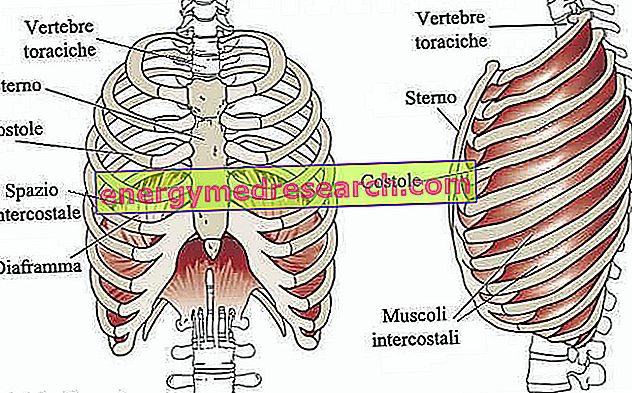Generality
The ribs, or ribs, are the 24 tapered and curved bones of the thoracic cage which, starting from the thoracic vertebrae, project almost to the anterior chest area.
Arranged in pairs, some of them are joined to the sternum by means of the costal cartilages (first seven pairs); others connect to the costal cartilages of those immediately above (8th, 9th and 10th pair); other anchors are free or "floating" (the last two pairs, 11th and 12th).

The main function of the ribs is to protect the vital organs (such as the heart and lungs) and the large blood vessels (such as aorta and hollow veins), located within the thoracic cavity.
What are ribs?
The ribs, or ribs, are the ribbon-shaped and arched bones that make up the lateral portions of the rib cage .
The latter is an osteo-cartilaginous complex, which, in addition to the ribs, also includes:
- The 12 thoracic vertebrae, posteriorly
- A bone called the sternum, anteriorly
- The costal cartilages, always anteriorly
Anatomical position of the rib cage
The rib cage is that skeletal structure placed in the upper part of the human body, exactly between the neck and the diaphragm.
Anatomy
The man has 24 ribs, arranged in 12 pairs . Each pair is connected, posteriorly, to one of the 12 thoracic vertebrae; obviously, from the left side of each thoracic vertebra the left ribs come, while from the right side of each thoracic vertebra they prevent the right ribs.
Each rib has, at the anterior end, its own costal cartilage ; the costal cartilages are tapered and short-length elements, made up of hyaline-type cartilaginous tissue.
Looking at the rib cage from top to bottom, the first 7 pairs of ribs project towards the sternum and make contact with it through the costal cartilages.
The eighth, the ninth and the tenth pairs are joined only indirectly to the sternum, as their costal cartilages flow towards the costal cartilages of the immediately higher coasts. In other words, the costal cartilages of the eighth pair join those of the seventh; the costal cartilages of the ninth pair join those of the eighth; finally, the costal cartilages of the tenth pair join those of the ninth.
The ribs that form the eleventh and twelfth pair are free and are also significantly shorter than the previous ones.
The space between the overlapping ribs is called the intercostal space . In the intercostal space reside muscles ( intercostal muscles ), nerves ( intercostal nerves ), arterial blood vessels and venous blood vessels.

Fig. Ribs of the rib cage of a human being. As the reader will notice, the length of the ribs is increasing up to the seventh pair. Then, from the eighth to the twelfth, it gradually decreases.
REAL RIBS AND FALSE RIBS
The doctors divide the ribs into true and false.
The true ribs are those that join the sternum through the costal cartilages; therefore the true coasts constitute the first 7 superior pairs.
The false ribs, on the other hand, are those connected to the ribs of the upper pair (always through the costal cartilages) and those completely free; therefore the false coasts are those from the eighth to the twelfth pair.
In reality, the ribs of the eleventh and twelfth pair are also called false floating ribs (or just floating ribs ); the term floating refers to their lack of connection with any other structure of the rib cage.
PARTS OF THE RIBS
The anatomists recognize in the ribs of the human being three main regions :
- The rear end . It is the region placed in connection with the reference vertebra. It has two particular areas, which doctors call the head of the coast and the neck of the coast. The head is the part in direct contact with the vertebra, while the neck is the portion of the rib immediately following.
- The front end . It is the region that is articulated with the costal cartilages.
- The body . It is the rib region between the back end and the front end.
At the point that separates the neck from the posterior extremity, there is a raised area, with a squat appearance, which takes the name of tubercle.
ARE THE LONG BONES?
In medical language, long bones are those bones that develop in length and contain bone marrow within them .
The ribs do not have, internally, any medullary canal; therefore, doctors prefer to describe the elongated shape with alternative terms to "long", in order not to create confusion.
A typical description of the morphology of the ribs is the following: "the ribs are flat, ribbon-shaped and arched bones".
SPECIAL FEATURES? OF CERTAIN RIBS
Since the first two pairs of ribs and the last two pairs have a particular aspect, we consider it appropriate to investigate some of their characteristics:
- The ribs of the first pair are the shorter and more curved ribs . Made in the shape of a C, they have a small head and a narrow neck; their head is in communication with the first thoracic vertebra.
They represent the point of contact for the anterior scalene muscles and give space to the passage of the succlavie veins.
The exact position of these ribs is immediately below the neck and just above the level of the clavicles.
- The ribs of the second pair have the same shape as the previous ones (so the curvature is the same) and are longer than a few centimeters.
Crossed by some intercostal blood vessels (both arterial and venous) and some intercostal nerves, they provide support for the posterior scalene muscles.
- The ribs of the eleventh and twelfth pair are very short (especially the last pair) and lack the neck and tubercle.
VARIATIONS AND ANOMALIES
The number and appearance of the ribs can vary, compared to normality (which is what has been reported so far).
Among the anomalies concerning the number of coasts, the most known and frequent is the so-called cervical rib (or cervical rib ). This defect - which consists in the presence of an extra rib, emerging from the last cervical vertebra - can be found in about one individual every 200-500 around; it mainly affects women and represents one of the main factors favoring thoracic outlet syndrome .
Additional ribs in other sites of the rib cage are a real rarity.
As far as morphological variations are concerned, there is the possibility that some ribs have the front end divided into two. Coasts with these structural anomalies are called bifid ribs or bifurcated ribs . According to some statistical studies, only about 1.2% of the population would carry one or more bifid ribs.
Functions
The ribs serve to protect the internal structures of the thoracic cavity, including the vital organs, heart and lungs, and the aorta, upper vena cava and inferior vena cava blood vessels.
ROLE IN BREATHING
Thanks to the intercostal muscles, the ribs also participate in some way in the respiratory act.
In fact, the muscular elements interposed between the coast and the coast allow the thoracic cage to expand, during the inspiration phase, so as to get more air into the lungs.
If the intercostal muscles did not exist or did not work properly (as happens in the presence of Duchenne muscular dystrophy, a serious muscular disease), the rib cage would not expand properly and the lungs would not be able to take in the air necessary for oxygenation of the whole organism.
It should not be forgotten that the diaphragm, the laminar muscle located on the lower edge of the rib cage, also participates in the respiratory process.
The role of the diaphragm is fundamental:
- In the inhalation phase, it contracts, pushing the abdominal organs downwards and inducing the lifting of the ribs closest to him. This expands the volume of the chest cavity and allows the lungs to take in the necessary air.
- In the exhalation phase, it is released, allowing the abdominal organs to ascend (NB: with the help of the contraction of the abdominal muscles) and the lower ribs to return to the normal position.
At these times, the thoracic volume is clearly reduced.
Note: the breathing just described, which involves the participation of diaphragm, ribs and abdominal muscles, is known as combined breathing .
Combined breathing differs from the less efficient apical breathing, in which the muscles of the cranio-cervical-thoracic system act.
Diseases of the ribs
Generally, due to trauma to the rib cage, the ribs may crack or fracture.
Cracking and fracture are two fairly common injuries to the ribs, affecting above all those who practice contact sports and those involved in road accidents.
Their gravity is different: a cracked rib is a coast that has suffered a strong bruise, but it is not broken; a fractured rib is instead broken into two stumps, which - if their extremities are pointed - can damage the blood vessels and / or organs of the thoracic cavity.
The typical symptom of a crack or fractured ribs is local pain, which tends to get worse when:
- The patient breathes deeply;
- There is compression of the injured chest area;
- The patient performs particular twisting or bending movements of the body.
In general, if treated properly, the cracked ribs heal within 4-6 weeks, while those fractured within 6-8 weeks.
| Major complications of a fracture and a crack in the ribs. | |
| Complications of rib fracture | Complications of rib cracking |
|
|



